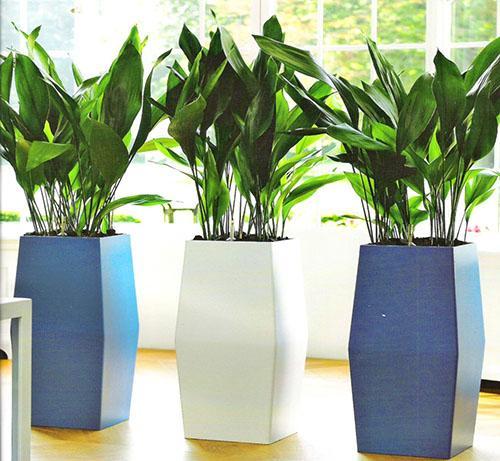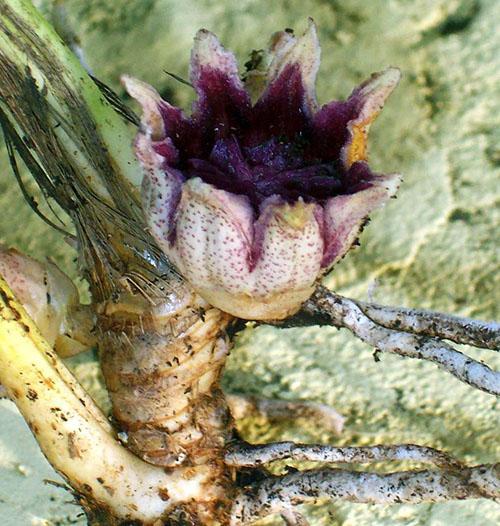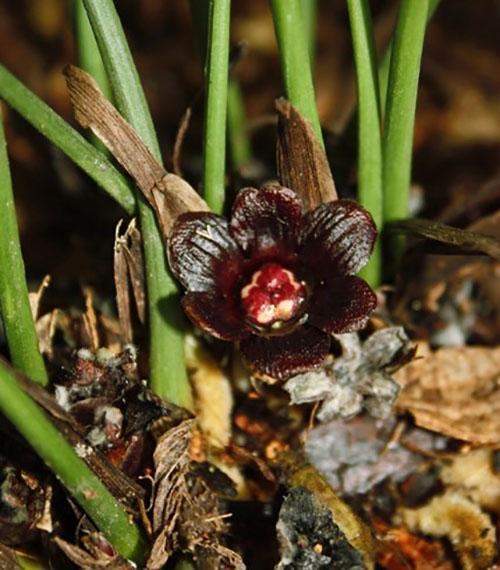Invisible miracle - the flower of the aspidistra
 For about a century, the green caps of the aspidistra can be seen not only in the homeland of the plant, in east and southeast Asia, but also in residential buildings and public buildings around the world. The plant is famous for its non-capricious disposition, easy adaptability and vitality. It feels good in a shaded room, cool and windy. Even a forgetful owner who forgets to water or, conversely, regularly floods the plant, the aspidistra will withstand all adversity and will grow as if nothing had happened.
For about a century, the green caps of the aspidistra can be seen not only in the homeland of the plant, in east and southeast Asia, but also in residential buildings and public buildings around the world. The plant is famous for its non-capricious disposition, easy adaptability and vitality. It feels good in a shaded room, cool and windy. Even a forgetful owner who forgets to water or, conversely, regularly floods the plant, the aspidistra will withstand all adversity and will grow as if nothing had happened.
They say that aspidistra belongs to long-lived indoor plants that can grow for several decades.
At the same time, not all lovers and connoisseurs of potted crops know what an aspidistra flower looks like. Nevertheless, the closest relative of the May lily of the valley, blooms every year, and the corollas formed on the plant are much larger than the flowers of the Russian forest culture. Why don't the growers see flowers, or does the aspidistra refuse to bloom at home for some reason?
Features of flowering aspidistra

Flowers, like leaves, are formed at the root. Moreover, if lily of the valley the peduncle is quite long, and the flowers form an inflorescence towering above the foliage, then the petiole of the aspidistra flower does not exceed a centimeter in length. Corollas are single, and with mass flowering, buds are formed along the rhizome at some distance from each other.
The uniqueness of the flowering of aspidistra is not only in where the flower is formed, but also in how it looks. In many respects, the flowers of the plant are a kind of record holder in the Asparagus family.
This is the number of perianths, which, depending on the species, can range from two to twelve, and the size and shape of the corolla. Moreover, it is the shape of the flower of aspidistra that is used to determine the belonging of a newly found plant to one or another species, which is extremely important because of the abundance of endemics among aspidistra with a very small habitat region.
 Aspidistra flowers are often dark purple, brown, violet, or other dark shades. In this case, the shape of the corolla can resemble, like a lily of the valley, a classic bell, be cupped or almost round.
Aspidistra flowers are often dark purple, brown, violet, or other dark shades. In this case, the shape of the corolla can resemble, like a lily of the valley, a classic bell, be cupped or almost round.
 The number of petals connected in the lower part, forming a flower, varies from 6 to 14, while their shape can be round, pointed or hypertrophically elongated, like the flower of the aspidistra grandifolia. As you can see in the photo, such a flower looks very much like a spider.
The number of petals connected in the lower part, forming a flower, varies from 6 to 14, while their shape can be round, pointed or hypertrophically elongated, like the flower of the aspidistra grandifolia. As you can see in the photo, such a flower looks very much like a spider.
 The purple flowers of the aspidistra zongbayi with six gracefully bent petals are often arranged very closely together, and the wilting corollas replace the newly opened buds.
The purple flowers of the aspidistra zongbayi with six gracefully bent petals are often arranged very closely together, and the wilting corollas replace the newly opened buds.
 The inner part of the flower, or perigone, also changes dramatically from species to species. Most species of this plant form bisexual flowers in which pollen is formed, and fertilization takes place immediately. However, recent studies suggest that in some cases, the flowering of aspidistra occurs through the formation of male and female flowers. An example of this is the aspidistra fungilliformis from Vietnam.
The inner part of the flower, or perigone, also changes dramatically from species to species. Most species of this plant form bisexual flowers in which pollen is formed, and fertilization takes place immediately. However, recent studies suggest that in some cases, the flowering of aspidistra occurs through the formation of male and female flowers. An example of this is the aspidistra fungilliformis from Vietnam.
Riddles of the aspidistra flower
 Today, when it would seem that there are almost no mysteries of nature left, the plant from the Asian forests tirelessly surprises botanists and asks questions. Until now, the mechanism of pollination of aspidistra has been very little studied. You can often hear that slugs carry pollen, but scientists tend to believe that this is just a fairy tale.
Today, when it would seem that there are almost no mysteries of nature left, the plant from the Asian forests tirelessly surprises botanists and asks questions. Until now, the mechanism of pollination of aspidistra has been very little studied. You can often hear that slugs carry pollen, but scientists tend to believe that this is just a fairy tale.
Nevertheless, back in the century before last, the botanist Frederico Delpino revealed the fact of cross-pollination of plants and nature. But who can help a plant with flowers barely visible above the forest floor or even hidden in it? At the same time, the peculiarity of the flowering of aspidistra is that the plants practically do not form nectar, and the aroma spreads only in a few species, for example, aspidistra campanulata and patentiloba.
In recent years, many studies and observations have been devoted to this issue. As a result, an international group of researchers was able to prove that aspidistra flowers located at the ground level, as in the photo, are pollinated in Vietnam by mushroom gnats and some species of flies, including gall midges.
But how things are in other regions is still unknown, which is due to the low availability of places where culture grows and the low visibility of the flowers of aspidistra themselves. But the pollinators of the flower of the species Aspidistra xuansonensis live and develop inside the corolla.
 These are the larvae of a tiny fly, for which the ripening pollen is food. When an adult insect forms from the larva, the fly emerges from the cavity inside the corolla of the aspidistra flower, as in the photo, and carries out pollen grains.
These are the larvae of a tiny fly, for which the ripening pollen is food. When an adult insect forms from the larva, the fly emerges from the cavity inside the corolla of the aspidistra flower, as in the photo, and carries out pollen grains.
When pollination occurs, a dense fruit begins to form in place of the flower, containing from one to several large seeds.
 There is another reason for the long unsolved riddle. Aspidistra blooms at the beginning of the rainy season in Asia. This feature interferes with scientists, but it will help a lover of indoor plants to activate the processes of bud formation and admire the rare aspidistra bloom at home.
There is another reason for the long unsolved riddle. Aspidistra blooms at the beginning of the rainy season in Asia. This feature interferes with scientists, but it will help a lover of indoor plants to activate the processes of bud formation and admire the rare aspidistra bloom at home.
In order not to miss the appearance of buds, it is imperative to remove all fallen or dried parts of the plant from the soil.
It will not be superfluous to remove some soil above the rhizome if it is too deep. Florists often miss the flowering of aspidistra. Since the buds simply cannot break through the compacted soil, or the length of the cutting is not enough to overcome the substrate layer.
You can stimulate the formation of flower buds by slightly reducing the intensity of watering, and then returning to the previous schedule. In this case, the aspidistra must be adult and well-formed. If the plant is weakened, waiting for flowers is unlikely to work.